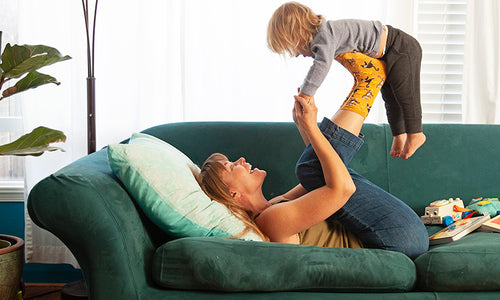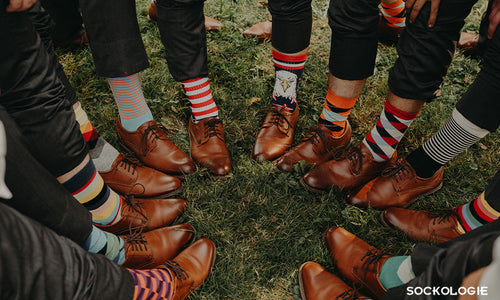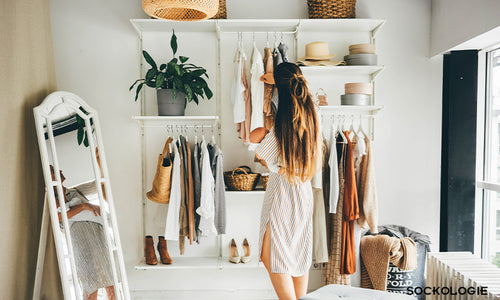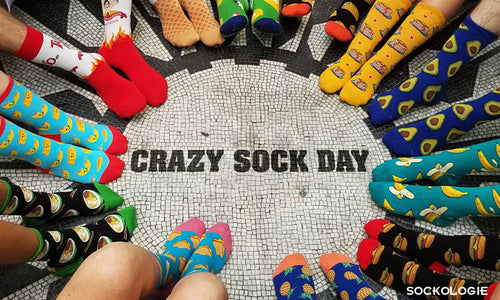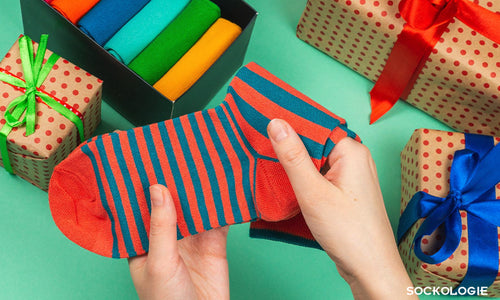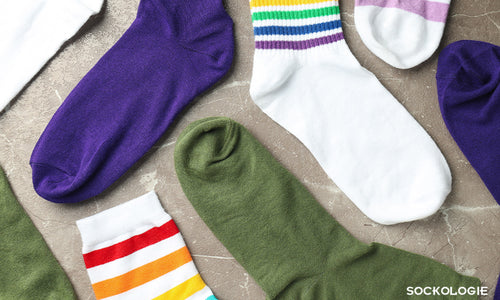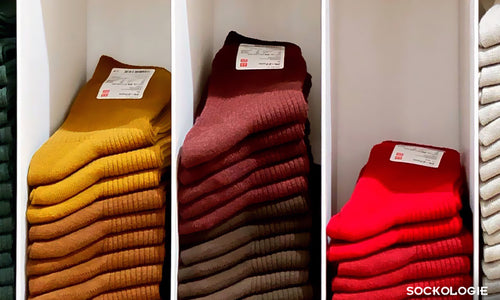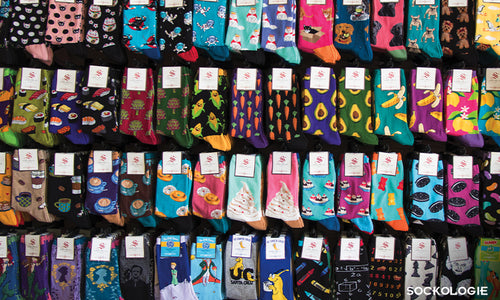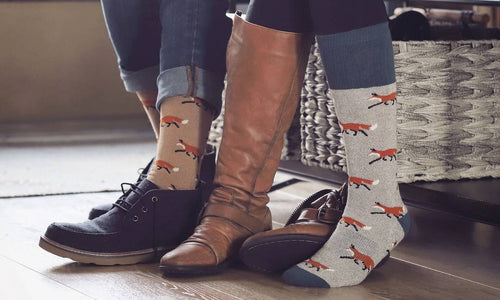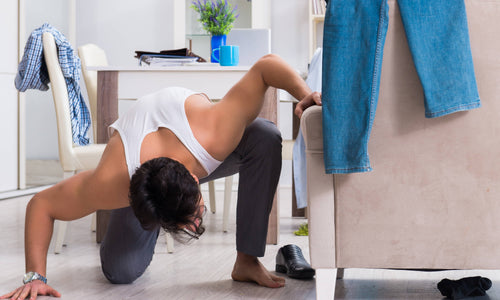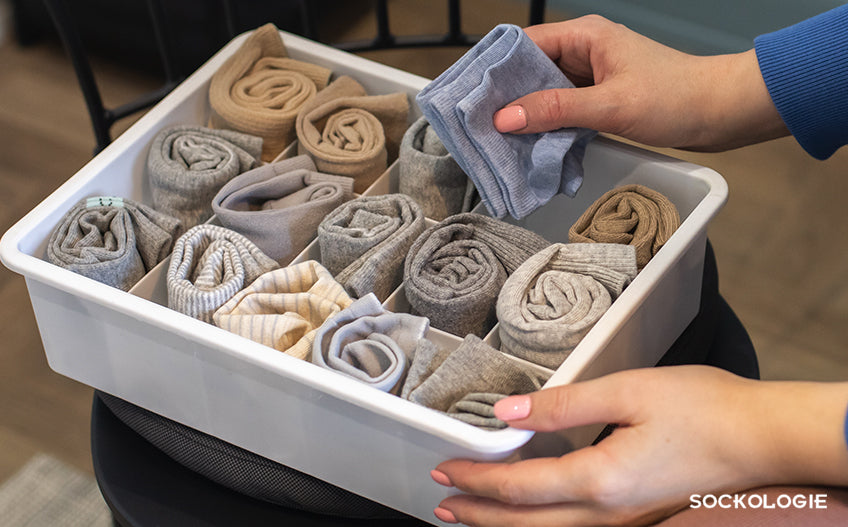
How to Fold Your Socks: Square Method, Roll, Military, and More
Socks can take up a surprising amount of space if you let them. Depending on the kind of sock you get, they can be thick, fluffy, and bulky, and you can quickly fill a drawer in your dresser with nothing but fun-patterned socks for various occasions.
Whether you're packing for a camping trip or a flight and need to use every bit of space in your luggage, or you're just trying to cram more socks into your drawer at home, folding is the key. But did you know that there are many different ways you can fold socks?
It's true, and they all work a little differently. Finding the ideal way to fold your socks isn't hard, but it's something many of us overlook, having only ever folded them the one way we learned growing up.
Well, it's time to learn and figure out the best way to fold the socks you love.
Table of Contents
Method 1: The Square Fold
The square fold is one of the most complicated folds on the list. It's a several step process that leaves you with a square bundle of socks, which can tile nicely in a drawer. Most importantly, though, it's very good at showing off the pattern or design of your socks, so you can see which socks you have available and pick the one that suits your mood.
Note that this works best if the pattern is in the middle of the sock. Some sock designs put most of their detail around the top hem and the toe and might not be as visible when folded in the square method. Most socks, though, will still show off the pattern enough that you can identify the socks you own.

How do you fold socks as a square? Here are our instructions. To ease confusion, we'll label the socks A and B as the two parts of a pair.
To more easily fold as a square, it can help straighten out your socks by pulling the sides out and creasing along them instead of front/back as socks are typically tucked. Also, while this method works best with straight socks, most socks are curved to fit your feet. This video demonstrates what we mean.
- Lay sock A out vertically in front of you.
- Lay sock B horizontally, on top of sock A, in a + formation.
- Pull the toe of sock A up and over sock B, tucking it under sock B. Be careful not to scrunch up sock B when you fold it over.
- Pull the cuff of sock A down and over its toe. It should hang over a little bit, but not too much.
- Fold the toe of sock B in, and tuck the overlap into the pocket formed by sock A.
- Fold the cuff of sock B over. It will hang over a little bit, just like the cuff of sock A.
- Tuck the cuff of sock B into the pocket beneath it.
- Tuck the cuff of sock A into the pocket beneath it.
- You should be left with a square of a sock, pattern visible, nicely folded, and tucked in.
As you can see, this folding method is a little intense. It's excellent for displaying socks, but if you have a few dozen pairs to fold and put away, it can take quite a bit of time and practice to get it right. It's more of a display fold than a good storage fold. Oh, and it works best with mid-length socks. Shorter socks like ankle socks are too short to tuck in, and long socks like thigh-high will leave a lot of excess material to handle.
Method 2: The Single Fold
The single-fold is, well, a fold in name only. It's only applicable if you are very careful with the way you handle and store your socks or if you're very worried about hurting the elasticity of your socks.

Once you read the instructions, you'll see why.
- Lay sock A flat on a surface.
- Lay sock B on top of it so they completely overlap.
- Fold both socks across each other, in half, cuff to toe.
- That's it; you're done.
The single-fold, along the angle of the sock, makes for a more even package. But, since there's no tucking, twisting, or otherwise packaging the socks together, they won't stay together. It's okay if you tuck them nicely into a drawer or suitcase, but the moment you pull something else from near them, they can just come undone. Plus, if they're loose, they can lose their match in the clutter of a drawer.
Method 3: The Cuff Tuck
This folding tip is a more advanced version of method two and uses the cuff of one sock to store both socks together. It's an excellent way to keep socks in pairs when you don't need to see their patterns as clearly (since the inner side of the cuff will usually cover it, so you'll be seeing the inside of the cuff) and keep them from separating as easily in a cluttered drawer.
The downside to this method is that it doesn't really work as well with smaller ankle socks and may need some extra folding for very long socks. On the plus side, it's fast to do!

It also stretches out one sock compared to the other so that you can end up with uneven socks over time.
- Lay sock A on a flat surface.
- Lay sock B on top of it so they fully overlap.
- Pick up the cuffs of both socks. Open one cuff and fold it down and over both socks.
You will tuck the entire sock into the folded cuff for smaller socks. For longer socks, you can fold it down just enough to hold the socks together and let the toes of the socks hang out.
It's a fast and easy fold, but it doesn't look great for most socks; it doesn't save you space and stretches out one of the two socks. It's primarily useful for short-term storage and to keep pairs of socks together, so they don't get separated.
Method 4: The Roll and The Military Roll
Named because of its use in the armed forces, this method of folding socks is by far one of the most space-efficient ways to fold socks. It's meant to allow you to pack away numerous pairs of socks in a very space-limited context, like a rucksack that needs to store pretty much all of your gear.
That makes it great for camping or for packing luggage. On the other hand, it's not quite as suitable for casual home use.
- Lay sock A on a flat surface.
- Lay sock B on top of it so they fully overlap.
- Starting at the toes, roll both socks upward together as tightly as possible.
- When your roll reaches the cuff, fold the cuff of sock A around the roll, enough to hold it in place.
It's simple, it's fast, and it's easy. What's not to love?

Well, the biggest downside of this method is the tuck. Like the cuff tuck method above, the military roll can stretch out the sock used to hold the pair together. This stretching won't necessarily be a problem if you alternate which sock is which (or if you wear through socks quickly enough that the stretching won't be a problem).
You can also choose not to tuck and roll your socks up. This strategy leaves them loose, though, and can make it harder to store them in a way that they won't just come loose at the first opportunity. You can also use little loops of string or rubber bands to hold them together, but then you're managing accessories, and if you're concerned enough about space that you're using a roll method, you don't want to deal with that.
To be clear:
- The Roll Method is when you roll your socks up.
- The Military Method is when you roll them up and use the cuff to tuck them together.
Other than that final step, the two methods are identical, so they're listed as the same one here.
Method 5: The Flip and Tuck
The flip and tuck method is like a quicker version of the square method. It leaves you with a square or rectangle sock shape, but it's not entirely as secure as the square method, and it's usually not quite as symmetrical.

This method also displays the top and cuff of the sock more than the middle, like the square method. If you're using your fold to help keep your socks easily identifiable, this works best if the sock has a design near the top instead of in the middle or nearer to the toe.
- Lay sock A on a flat surface.
- Lay sock B on top of it so they fully overlap.
- Fold the toes of both socks up and over, about half to a third of the way up.
- Fold the cuffs of both socks down, and tuck the toes into the top cuff.
This method can take a bit of practice to get right. If you fold too much up and over, you won't be able to tuck it into the cuff as effectively. Also, you may need to do multiple folds instead of just one for longer socks to save the most space.
This method is a lot like a faster, less tight roll method, so it has many of the same pros and cons. Most notably, it doesn't save as much space and still can stretch out a single sock's cuff. On the plus side, it's a little faster. The result is also a lot like a military roll.
Method 6: The Sock Ball Method
This method works for just about any sock but works best for longer and bulkier socks. It's fast, easy, and somewhat condensed, but it's also asymmetrical so that it can stretch out one sock, similar to many other methods. It also works best when you want a quick fold that isn't very photogenic and you don't care about displaying patterns or keeping your socks nice-looking.

Here's how to do it.
- Lay sock A on a flat surface.
- Lay sock B on top of it so they fully overlap.
- Fold the toes up to the cuffs, like in the single fold method.
- Grasp the inner of the two cuffs and fold it down around the whole bundle, which leaves you with a ball of socks held together by the one cuff.
It's quick and easy, but since you're stuffing two socks into the cuff of one, it's pretty easy to stretch out your socks this way. It's okay if you have a lot of identical socks and want to fold and store them, but it has a lot of drawbacks otherwise, so we don't recommend it.
Which Method is Best?
The truth is, the best method for storing socks is the method that works for you. Some people like to get sock organizers. Some people prefer the square technique to put their novelty socks on display. Some people need the space and pick a roll or military roll method. Some people buy loads of identical socks and throw them into a drawer without a care, just grabbing two socks when they need to cover their feet.

The method you choose comes down to your goals. Do you want to save space? Military roll is the way to go. Do you want to preserve your socks for as long as possible? A single fold or roll without the tuck does best. Do you want to display your socks?
Square fold is usually the quick organization method that you can use every day without taking much time. Some of the other methods might be a better space-saving technique, like when you're about to pack a suitcase and go on vacation, for example.
It's all down to you and what you want out of your sock drawer. It makes your socks easier to find, gives you more space, and makes them easier to pack!
